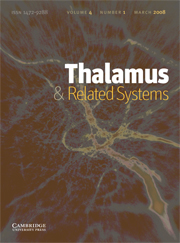Article contents
Reorganization of barrel circuits leads to thalamically-evoked cortical epileptiform activity
Published online by Cambridge University Press: 25 May 2007
Abstract
We have studied circuit activities in layer IV of rat somatosensory barrel cortex that contains microgyri induced by neonatal freeze lesions. Structural abnormalities in GABA-containing interneurons are present in the epileptogenic paramicrogyral area (PMG). We therefore tested the hypothesis that decreased postsynaptic inhibition within barrel microcircuits occurs in the PMG and contributes to epileptogenesis when thalamocortical afferents are activated. In thalamocortical (TC) slices from naïve animals, single electrical stimuli within the thalamic ventrobasal (VB) nucleus evoked transient cortical multi-unit activity lasting 65 ± 42 msec. Similar stimuli in TC slices from lesioned barrel cortex elicited prolonged (850 ± 100 msec) paroxysmal discharges that originated in the PMG and propagated laterally over several mm. The duration of paroxysmal discharges were shortened by ∼70% when APV was applied and were abolished by CNQX. The cortical paroxysmal discharges did not evoke thalamic oscillations. Whole-cell patch-clamp recordings show that there is a shift in the balance of TC-evoked responses in the PMG that favors excitation over inhibition. Dual, whole-cell recordings in layer IV of the PMG indicated that selective loss of inhibition from fast-spiking interneurons to spiny neurons in the barrel circuits is likely to contribute to unconstrained cortical recurrent excitation with generation and spread of paroxysmal discharges.
Information
- Type
- Research Article
- Information
- Copyright
- © 2007 Cambridge University Press
- 11
- Cited by

